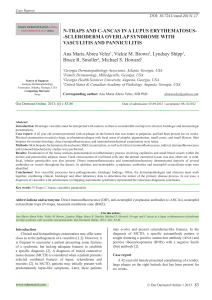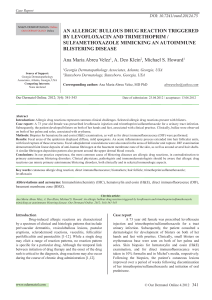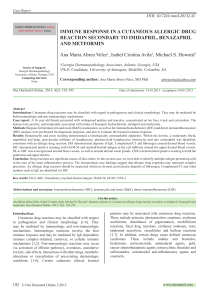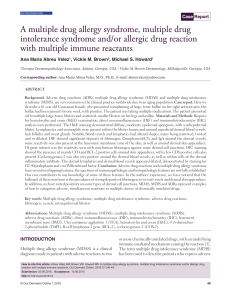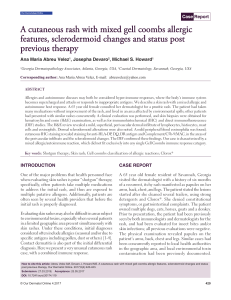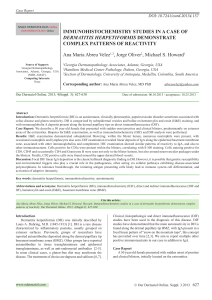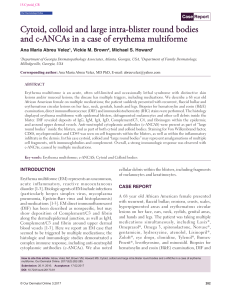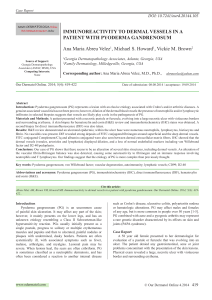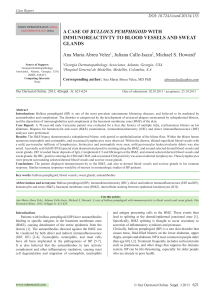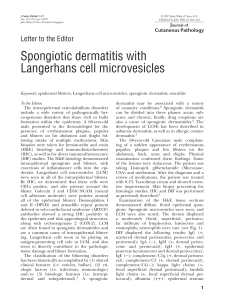N-Traps and C-ancas in a lupus-scleroderma overlap syndrome-
advertisement
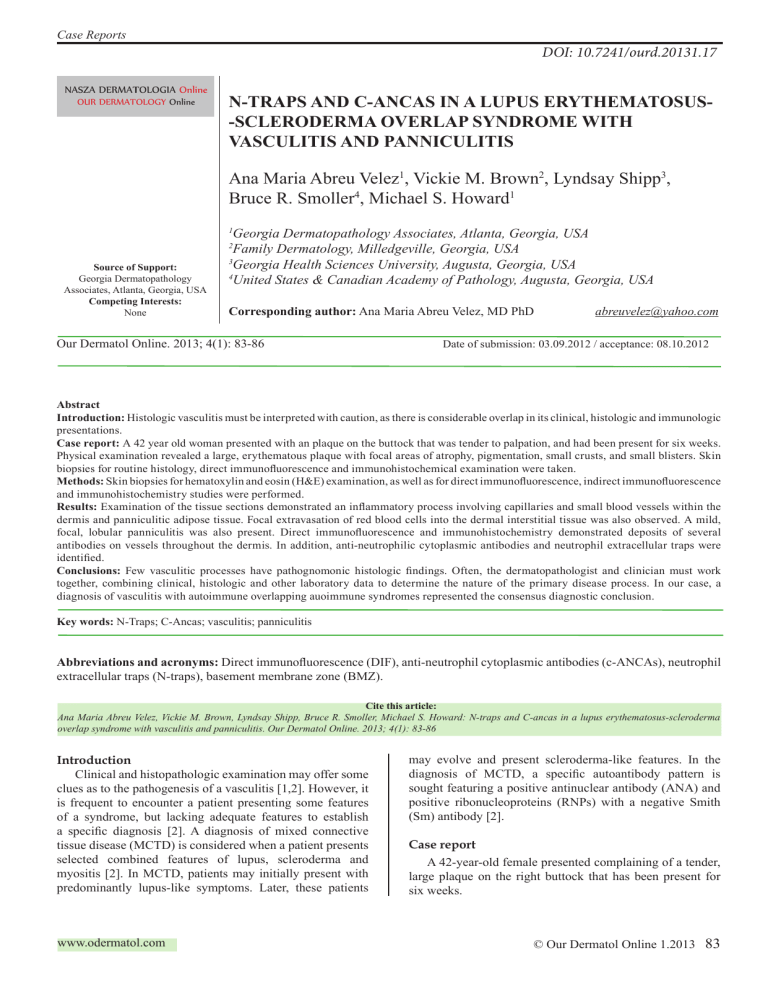
Case Reports DOI: 10.7241/ourd.20131.17 N-TRAPS AND C-ANCAS IN A LUPUS ERYTHEMATOSUS-SCLERODERMA OVERLAP SYNDROME WITH VASCULITIS AND PANNICULITIS Ana Maria Abreu Velez1, Vickie M. Brown2, Lyndsay Shipp3, Bruce R. Smoller4, Michael S. Howard1 Georgia Dermatopathology Associates, Atlanta, Georgia, USA Family Dermatology, Milledgeville, Georgia, USA 3 Georgia Health Sciences University, Augusta, Georgia, USA 4 United States & Canadian Academy of Pathology, Augusta, Georgia, USA 1 2 Source of Support: Georgia Dermatopathology Associates, Atlanta, Georgia, USA Competing Interests: None Corresponding author: Ana Maria Abreu Velez, MD PhD Our Dermatol Online. 2013; 4(1): 83-86 abreuvelez@yahoo.com Date of submission: 03.09.2012 / acceptance: 08.10.2012 Abstract Introduction: Histologic vasculitis must be interpreted with caution, as there is considerable overlap in its clinical, histologic and immunologic presentations. Case report: A 42 year old woman presented with an plaque on the buttock that was tender to palpation, and had been present for six weeks. Physical examination revealed a large, erythematous plaque with focal areas of atrophy, pigmentation, small crusts, and small blisters. Skin biopsies for routine histology, direct immunofluorescence and immunohistochemical examination were taken. Methods: Skin biopsies for hematoxylin and eosin (H&E) examination, as well as for direct immunofluorescence, indirect immunofluorescence and immunohistochemistry studies were performed. Results: Examination of the tissue sections demonstrated an inflammatory process involving capillaries and small blood vessels within the dermis and panniculitic adipose tissue. Focal extravasation of red blood cells into the dermal interstitial tissue was also observed. A mild, focal, lobular panniculitis was also present. Direct immunofluorescence and immunohistochemistry demonstrated deposits of several antibodies on vessels throughout the dermis. In addition, anti-neutrophilic cytoplasmic antibodies and neutrophil extracellular traps were identified. Conclusions: Few vasculitic processes have pathognomonic histologic findings. Often, the dermatopathologist and clinician must work together, combining clinical, histologic and other laboratory data to determine the nature of the primary disease process. In our case, a diagnosis of vasculitis with autoimmune overlapping auoimmune syndromes represented the consensus diagnostic conclusion. Key words: N-Traps; C-Ancas; vasculitis; panniculitis Abbreviations and acronyms: Direct immunofluorescence (DIF), anti-neutrophil cytoplasmic antibodies (c-ANCAs), neutrophil extracellular traps (N-traps), basement membrane zone (BMZ). Cite this article: Ana Maria Abreu Velez, Vickie M. Brown, Lyndsay Shipp, Bruce R. Smoller, Michael S. Howard: N-traps and C-ancas in a lupus erythematosus-scleroderma overlap syndrome with vasculitis and panniculitis. Our Dermatol Online. 2013; 4(1): 83-86 Introduction Clinical and histopathologic examination may offer some clues as to the pathogenesis of a vasculitis [1,2]. However, it is frequent to encounter a patient presenting some features of a syndrome, but lacking adequate features to establish a specific diagnosis [2]. A diagnosis of mixed connective tissue disease (MCTD) is considered when a patient presents selected combined features of lupus, scleroderma and myositis [2]. In MCTD, patients may initially present with predominantly lupus-like symptoms. Later, these patients www.odermatol.com may evolve and present scleroderma-like features. In the diagnosis of MCTD, a specific autoantibody pattern is sought featuring a positive antinuclear antibody (ANA) and positive ribonucleoproteins (RNPs) with a negative Smith (Sm) antibody [2]. Case report A 42-year-old female presented complaining of a tender, large plaque on the right buttock that has been present for six weeks. © Our Dermatol Online 1.2013 83 On physical examination, the right buttock and superior lateral thigh revealed a large, edematous, erythematous area with focal hyperpigmentation, inflamed crusts, small bullae and atrophy. The lesion was tender to touch and indurated. The patient described occasional “shooting pains” in the area of the plaque Skin biopsies were taken for hematoxylin and eosin (H&E) analysis. Biopsies for direct immunofluorescence (DIF) and immunohistochemisty (IHC) studies were also obtained. The patient was treated with delayed release Diclofenac sodium for one month, and a tapering course of prednisone. The patient did not improve significantly on this regimen, but colchicine was then given with clinical improvement. Notably, upon clinical improvement her N-traps and c-ANCAs disappeared. Methods Hematoxylin and eosin (H&E) stained sections and direct immunofluorescence (DIF) slides were prepared as previously described [2,3]. For DIF, multiple frozen section sets were cut at four microns thickness. DIF was then performed utilizing monoclonal immunoreactants to IgG, IgA, IgM, IgD, IgE, Complement/C1q, Complement/C3, Complement/C4, albumin and fibrinogen (all from Dako, Carpinteria, California, USA). Immunohistochemistry (IHC) was performed as previously described [2,3]. For the IHC studies, we utilized antibodies to IgG, IgA, IgM, IgD, IgE, Complement/C1q, Complement/ C3c, Complement/C3d, fibrinogen, albumin, kappa light chains, lambda light chains, CD45, CD68, myeloproxidase, Complement/C5-9/MAC, HLA-DPDQDR, thrombomodulin, vimentin, ribonucleoprotein (RNP) and vascular endothelial growth factor (VEGF). Serologic testing: All ANAs, ANCAs and renal tests were within normal limits, but the patient had already completed a tapering course of prednisone. The H&E, DIF and the IHC studies were performed before initiation of immunosuppresive therapy. Results Microscopic examination: Examination of the H&E stained tissue sections demonstrated a mild inflammatory process involving capillaries and small blood vessels within the dermis and subcutaneous panniculus. No fibrinoid changes were identified within blood vessel walls, and minimal leukocytoclastic debris was appreciated. Focal extravasation of red blood cells into the dermal interstitial tissue was observed. No granulomatous inflammation was present (Fig. 1, 2). DIF studies demonstrated strong staining with FITC conjugated Complement/C3, C1q, IgD, IgG and fibrinogen in blood vessels at all levels of the dermis and panniculus. In addition, FITC conjugated IgA, albumin and IgG antibodies were positive for neutrophil extracellular traps (N-Traps). Anti-neutrophil cytoplasmic antibodies (c-ANCAs), were positive with FITC conjugated IgM and Complement/C3 antibodies. IgE was positive in a shaggy, linear pattern along the basement membrane zone. IHC studies revealed strong positivity with anti-human IgG, IgM, IgG, Complement/ C1q, and fibrinogen around the dermal blood vessels. IgA clearly colocalized with the N-Traps when utilizing the myeloperoxidase stain. Significantly, CD68 staining was 84 © Our Dermatol Online 1.2013 negative in the N-Trap areas. Complement/C5-9/MAC and HLA-DPDQDR were strongly localized around all vessels throughout the dermis and panniculus (Fig. 1, 2). Ribosomal nucleoprotein (RNP) was positive on the upper layer of the epidermis, within sebaceous glands and in many small vessels of the dermis. Vimentin showed compartmentalization around dermal blood vessels and around dermal appendageal structures. Discussion The constellation of clinical, histologic and immunofluorescence features is best characterized as an overlap syndrome with features of lupus erythematosus and scleroderma and including histologic vasculitis and panniculitis [1,4,5]. The histologic findings of small and medium sized vessel vasculitis in association with an early lobular panniculitis support this diagnostic concept; however, some of the observed immunoreactivity did not support our diagnosis, including shaggy deposits of IgE at the BMZ. The clinical etiology of the vasculitis was not certain, given the histologic features present. No histologic granulomatous inflammation was present, although we did consider a differential diagnosis of granulomatosis with polyangiitis (Wegener’s syndrome), previously documented as a neutrophilic vasculitis that can feature N-traps and c-ANCAs [5-8]. Our DIF findings of IgA positivity warranted a review of the patient’s renal function, which was within normal limits. Previous ANA and ANCA studies were also within normal limits; however, these studies were performed when the patient had received therapeutic systemic steroids for several months. In contradistinction, our DIF studies were performed when the patient had not received recent immunosuppressive therapy, and the c-ANCA and N-trap studies were positive at that time. Neutrophils constitute a first line of defense against many infectious agents. When attempting to eliminate pathogens, neutrophils release neutrophil extracellular traps (N-traps), chromatin fibers coated with antimicrobial proteins. N-traps trap and destroy pathogens very efficiently, thereby minimizing tissue damage [4,6-8]. Further, N-traps modulate inflammatory responses by activating plasmacytoid dendritic cells. In addition, one study demonstrated that N-traps released by human neutrophils can directly prime T cells by reducing their activation threshold. N-trap-mediated T cell activation thus augments a documented array of neutrophil functions, and demonstrates a novel link between innate and adaptive immune responses [7]. In our case, we further document associated T cells and N-traps in the same autoimmune process. Regarding our observed shaggy pattern IgE anti–BMZ autoantibodies, we could not find any previous report of a vasculitic process demonstrating this specific pattern. IgE anti-BMZ antibodies may present in bullous pemphigoid in a linear pattern, but would not be expected to demonstrate the overall pattern of IgE in a lupus band [9]. The clinical and pathological significance of our finding remains uncertain. In conclusion, very few vasculitic processes have pathognomonic histologic findings; thus, often the dermatopathologist and clinician must combine clinical, histological, and laboratory data to determine the nature of the primary disease process. REFERENCES 1. Smoller BR, McNutt NS, Contreras F: The natural history of vasculitis. What the histology tells us about pathogenesis. Arch Dermatol. 1990;126:84-9. 2. Maddison PJ: Overlap syndromes and mixed connective tissue disease. Curr Opin Rheumatol. 1991;3:995–1000. 2. Abreu-Velez AM, Howard MS, Hashimoto K, Hashimoto T: Autoantibodies to sweat glands detected by different methods in serum and in tissue from patients affected by a new variant of endemic pemphigus foliaceus. Arch Dermatol Res. 2009;301:7118. 4. Kelley JM, Monach PA, Ji C, Zhou Y, Wu J, Tanaka S, et al: IgA and IgG antineutrophil cytoplasmic antibody engagement of Fc receptor genetic variants influences granulomatosis with polyangiitis. Proc Natl Acad Sci USA. 2011;108:20736-41. 5. Abreu-Velez AM, Loebl AM, Howard MS: Autoreactivity to sweat and sebaceous glands and skin homing T cells in lupus profundus. Clin Immunol. 2009;132:420-4. 6. Abreu-Velez AM, Smith JG Jr, Howard M: Presence of neutrophil extracellular traps and antineutrophil cytoplasmic antibodies associated with vasculitides. N Am J Med Sci. 2009;1:309-13. 7. Tillack K, Breiden P, Martin R, Sospedra M: T lymphocyte priming by neutrophil extracellular traps links innate and adaptive immune responses. J Immunol. 2012;188:3150-9. 8. Villanueva E, Yalavarthi S, Berthier CC, Hodgin JB, Khandpur R, Lin AM et al: Netting neutrophils induce endothelial damage, infiltrate tissues, and expose immunostimulatory molecules in systemic lupus erythematosus. J Immunol. 2011;187:538-52. 9. Woodley DT: The Role of IgE anti–basement membrane zone autoantibodies in bullous pemphigoid. Arch Dermatol. 2007;143:249-50. Figure 1. a. Clinical lesions on the buttock featuring large plaques, with focal hyperpigmented, erythematous and atrophic areas. b. DIF demonstrating FITC conjugated IgA N-traps being extruded through the corneal layer of the skin (green/white staining; white arrow). c. DIF demonstrating N-traps within dermal blood vessels (white staining; red arrows). d. IHC demonstrating N-traps, highlighted by positive staining against myeloperoxidase (brown staining; red arrows). e. IHC demonstrating N-traps, highlighted by positive staining for IgA (brown staining; red arrows). f. DIF demonstrating IgM positivity around dermal sweat glands (white/greenish staining; white arrows). g. H&E, demonstrating the inflammatory infiltrate around dermal blood vessels and focal dermal sclerodermoid areas. h. DIF demonstrating IgE shaggy deposits at the BMZ (green staining; white arrow). i. IHC demonstrating positive staining of fibrinogen around dermal blood vessels. © Our Dermatol Online 1.2013 85 Figure 2. a. Focal H&E sclerodermoid histologic alterations in the dermis (100x). b. Demonstrates the H&E inflammatory process involving capillaries and small blood vessels of the dermis (200x). c. IHC demonstrating Complement/C3 positive staining around dermal blood vessels (10x), and in. d. at higher magnification (400x) (brown staining; red arrows). e. and f. DIF of FITC conjugated IgA in. e. and albumin in f, demonstrating positive staining against dermal blood vessels (green/white staining; white arrows). g. Positive IHC staining with CD45 of cells around dermal blood vessels (brown staining; red arrow). h. Positive IHC staining with HLA-DPDQDR around the dermal blood vessels (brown staining; red arrows). i. Positive IHC staining with the Complement/ MAC/C5-B9 complex around dermal blood vessels (brown staining; red arrow). Copyright by Ana Maria Abreu Velez et al. This is an open access article distributed under the terms of the Creative Commons Attribution License, which permits unrestricted use, distribution, and reproduction in any medium, provided the original author and source are credited. 86 © Our Dermatol Online 1.2013
